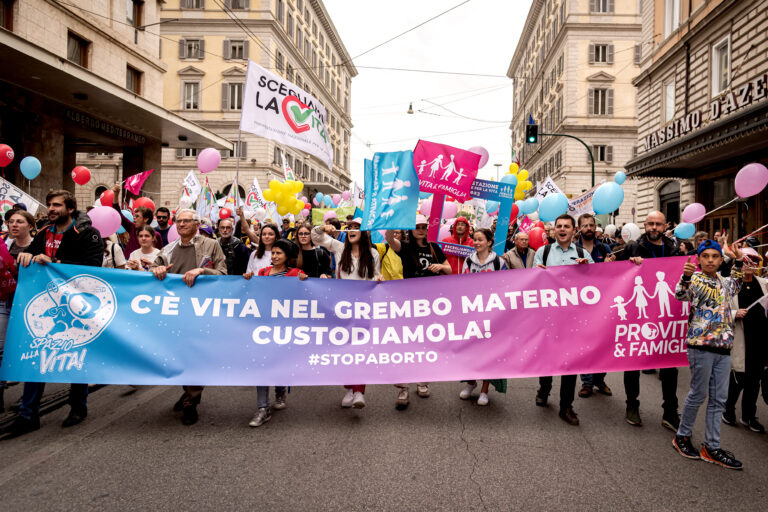In the name of promoting reproductive health, three key United Nations agencies plan to formally promote a radical population control and abortion agenda in refugee settlements. According to the United Nations Population Fund (UNFPA) and the United Nations High Commissioner for Refugees (UNHCR), if a “refugee settlement has a population of over 10,000, then there should be a facility for uterine evacuation within its boundaries to deal with the complications of unsafe abortion.”1 The World Health Organization (WHO) likewise encourages the use of abortion, stipulating that primary health care facilities in refugee camps around the world should “provide elective abortion services by vacuum aspiration” and “establish referral service for later stages”2 wherever abortion is legal.
Refugees targeted over time
As early as 1995, the UN and its associated agencies (notably the UNHCR, UNFPA and WHO), began discussing the introduction of chemical and surgical abortion as an integral part of their aid in refugee situations. Documents currently being finalized3 propose the integration of such procedures into the basic health services delivered to refugee populations. The documents under discussion call for the introduction of chemical and surgical abortion in refugee camps throughout the world, regardless of the legal, cultural, and religious backgrounds of the nations involved. The proposed UN regulations advocate the provision of abortion services in the most unsafe and unhygienic conditions imaginable, endangering the lives of the most vulnerable, poverty-stricken women in the world.
These proposed policies directly violate the UN’s repeated commitment to respect the religious and ethical values, cultural backgrounds and philosophical convictions, and sovereign equality, of its member states.”4 Critics point out that the various UN agencies are unquestionably aware of the contradiction between their abortion agenda and the laws, culture and religion of many developing nations and have responded by explicitly outlining the ways in which aid workers can circumvent national abortion laws .5 Such blatant disregard for the lives of refugee women and their unborn children often by the only institutions that have the power to protect them, and for the laws of UN member states has led to demands for immediate investigation and rectification.
Action and reaction
In an official statement (on following page), Congressman Chris Smith expressed that the documents threaten to break the consensus that has been established within the UN community, and urged UN Secretary General Annan to reconsider and reject the proposed mandate. In a press interview, the Congressman characterized the proposed programs as a “radical re-write” of what has been abortion policy, and that “payment of US arrears to the United Nations could be endangered by the integration of abortion into the work of its agencies.”
Recognizing the controversial character of these guidelines, background documents make explicit recommendations to draft “alternative terminology” to minimize the opposition that will arise in the face of this “sensitive issue.” Because there will be “legal obstacles to the provision of abortion in the country of asylum,” agencies arc directed to devise a “terminology that might fit into legal limitations.” Terms such as “menstrual regulation or evacuation can serve to reduce the sensitive nature of the subject matter, and should therefore be employed.” The background documents emphatically assert that “regardless of legal status, humane treatment for women requires the provision of safe abortion,” and that “the legal right of maternal health should not be neglected and that it should indeed not be ‘secondary’ to the laws against abortion.”6
Congressman Smith and other human rights advocates find it outrageous that the UN sponsors programs that, in its own recognition, stand in violation of the laws of its member states. It is outrageous that it promotes programs that violate in many eases the desires of refugee populations who, in the words of the documents, desire to replace lost children,7 or see family planning as a kind of ethnic cleansing.8 They are very upset that these plans advocate the introduction of services such as manual vacuum aspiration and emergency contraception into situations where the minimal requirements of hygiene, sterile facilities or professional diagnosis and supervision are impossible to meet. They point out the proposed UN policy amounts to nothing less than the foreign imposition of a radical Western agenda on the poorest and most vulnerable members of society, and a blatant attempt to interfere with the national sovereignty of developing countries.
And this protest may have a significant impact on the proposals. The present Administration has requested a 1998 contribution to the UN in excess of one billion dollars. Given that it is one of the largest supporters of the UN, the United States holds in its hand a unique opportunity to protest and prevent the implementation of this population control agenda. Human rights advocates say the US finds itself standing at a crossroads. It can either acquiesce with the UN in imposing abortion on refugees throughout the world, or it can reaffirm its commitment to respect the culture of other nations, refuse to allow US taxpayer dollars to finance such “travesties of aid,” exert sustained pressure on the UN and associated agencies to remove all references to abortion and abortifacients, and re-focus international aid where it should always remain: on the provision of shelter, sanitation, adequate food, clean water and basic health care.
Endnotes
1 UNHCR and UNFPA, An Inter-Agency Field Manual: Reproductive Health in Refugee Situations, p. 55.
2 WHO, Reproductive Health Services in Conflict and Displacement (RHSCD), table 5.1, p. 60.
3 UNHCR/UNFPA, Reproductive Health in Refugee Situations. An Inter-agency Field Manual. WHO, Reproductive Health Services in Conflict and Displacement (RHSCD).
4 See for instance the Charter of the United Nations, Preamble and Chapter 1. This commitment is reaffirmed in the introduction of the UNHCR/UNFPA field manual.
5 UNHCR/UNFPA, Proceedings of the Second Preparatory Meeting on Reproductive Health in Refugee Situations (RSPM), Geneva: April 5-6, 1995, working group 8. This preparatory meeting, although sponsored by the UNHCR and UNFPA, had a very large representation from WHO, sending 21 of the 66 participants in the meeting.
6 Al of the above recommendations stand in the preparatory meeting, RSPM, Working Group 8. In its resource packet, Emergency Contraceptive Pills, “A Framework for Introduction,” 3, the WHO addresses the need to correct “misinformation that exists regarding [emergency contraceptive pills’] mode of action (i.e., the erroneous belief that ECPs act as abortifacients)”, claiming that pregnancy begins only upon implantation (“Questions and Answers for Decision-Makers,” 1).
7 RSPM, Working Group 8; RHSCD, 5.4, 72.
8 RHSCD, 3.4.2, 37.










